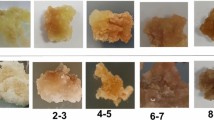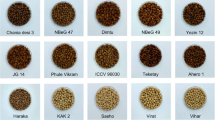Abstract
Glucosinolates are well known functional food components that were discovered in Cruciferae and have been the object of study from diverse disciplinary perspectives, including metabolism, quantitative analysis, and breeding. However, the effects of the growth environment and post-harvest processes on glucosinolate production in Chinese cabbage are not well studied. Hence, this study aimed to identify the major factors that affect glucosinolate accumulation in Chinese cabbage during growth, and to optimize growth conditions in order to maximize glucosinolate content. Therefore, we measured glucosinolate content in cabbage grown in five environmental conditions that altered electrical conductivity, pH, cultivation time, temperature, and relative humidity. We used principal component analysis (PCA) to identify the variables primarily affecting growth, followed by response surface methodology (RSM) to determine optimal growth conditions that maximize glucosinolate content in Chinese cabbage. Results from PCA indicated that cultivation time, temperature, and relative humidity were the principal components that explained 85.8% of the total variance, suggesting these are the most significant environmental factors that affect glucosinolate accumulation. Moreover, RSM indicated that the total model for evaluating glucosinolate content was significant (R2 = 0.934) and showed that the optimal temperature and relative humidity for maximizing glucosinolate content are 28 °C, and 66%, respectively. This study provided practical information of optimal condition for producing functional Chinese cabbage intensifying glucosinolate.


Similar content being viewed by others
References
Afifi A, May S, Clark V (2011) Practical multivariate analysis, 5th edn. CRC Press, Boca Raton
Barnett V, Lewis T (1994) Outliers in statistical data, 3rd edn. Wiley, New York
Brown AF, Yousef GG, Jeffery EH, Klein BP, Wallig MA, Kushad MM, Juvik JA (2002) Glucosinolate profiles in broccoli: variation in levels and implications in breeding for cancer chemoprotection. J Am Soc Hortic Sci 127:807–813
Cartea ME, Velasco P, Obregón S, Padilla G, Haro A (2008) Seasonal variation in glucosinolate content in Brassica oleracea crops grown in northwestern Spain. Phytochemistry 69:403–410
Charron CS, Saxton AM, Sams CE (2005) Relationship of climate and genotype to seasonal variation in the glucosinolate-myrosinase system. I. Glucosinolate content in ten cultivars of Brassica oleracea grown in fall and spring seasons. J Sci Food Agric 85:671–681
Chen Z, Gu H, Li Y, Su Y, Wu P, Jiang Z, Ming X, Tian J, Pan N et al (2003) Safety assessment for genetically modified sweet pepper and tomato. Toxicology 188:297–307
Chen X, Zhu J, Gerendás J, Zimmermann N (2008) Glucosinolates in Chinese Brassica campestris vegetables: Chinese cabbage, purple cai-tai, choysum, pakchoi, and turnip. HortScience 43:571–574
Cho DW, Oh JP, Chung KH (2009) Comparison of the agricultural characters between the functional GM Chinese cabbage and its control grown in the central districts of Korea. Korean J Int Agric 21:199–205
Choi SH, Kim SM (2012) Quality properties of giant squid (Dosidicus gigas) surimi-based product manufactured with Amorphophallus konjac flour. Korean J Food Sci Technol 44:422–427
Choi BS, Lim JE, Shin YK, Yang JE, Lee SS, Ok YS (2011) Effect of waste nutrient solution and reclaimed wastewater on Chinese cabbage growth and soil properties. Korean J Soil Sci Fertil 44:394–399
Ciska E, Martyniak-Przybyszewska B, Kozlowska H (2000) Content of glucosinolates in cruciferous vegetables grown at the same site for two years under different climatic conditions. J Agric Food Chem 48:2862–2867
Eum HL, Kim BS, Yang YJ, Hong SJ (2013) Quality evaluation and optimization of storage temperature with eight cultivars of Kimchi cabbage produced in summer at highland areas. Korean J Hortic Sci Technol 31:211–218
Fenwick GR, Heaney RK, Mullin WJ, VanEtten CH (1983) Glucosinolates and their breakdown products in food and food plants. CRC Crit Rev Food Sci Nutr 18:123–201
Fritz VA, Justen VL, Bode AM, Schuster T, Wang M (2010) Glucosinolate enhancement in cabbage induced by jasmonic acid application. HortScience 45:1188–1191
González G, Péna-Méndez E (2000) Multivariate data analysis in classification of must and wine from chemical measurements. Eur Food Res Technol 212:100–107
Halkier BA, Gershenzon J (2006) Biology and biochemistry of glucosinolates. Annu Rev Plant Biol 57:303–333
Hill CB, Williams PH, Carlson DG, Tookey HL (1987) Variation in glucosinolates in oriental brassica vegetables. J Am Soc Hortic Sci 112:309–313
Horn PS, Feng L, Li Y, Pesce AJ (2001) Effect of outliers and nonhealthy individuals on reference interval estimation. Clin Chem 47:2137–2145
Hwang SW, Lee JY, Hong SC, Park YH, Yun SG, Park MH (2003) High temperature stress of summer Chinese cabbage in apline region. Korean J Soil Sci Fert 36:417–422
Im JN, Yoo SH (1986) Modeling of estimating soi1 moisture, evapotranspiration and yield of Chinese cabbages from meteorological data at different growth stages. Korean J Soil Sci Fertil 21:386–408
Jeong NR, Chun JH, Park EJ, Lim YH, Kim SJ (2015) Variations of glucosinolates in kale leaves (Brassica oleracea var. acephala) treated with drought-stress in autumn and spring seasons. Korean J Agric Sci 42:167–175
Johnson RA, Wichern DW (2014) Applied multivariate statistical analysis, vol 4. Prentice-Hall, NJ
Jolliffe I (2002) Principal component analysis. Wiley, New York
Jung JI, Hong EY, Kim MK, Jung JW, Oh JY, Kwon MS, Lee KP, Kim GH (2009) Changes in total glucosinolates levels and physico-chemical properties of Kimchi using Korean Chinese cabbage of harvest time according to various storage conditions. Korean J Food Preserv 16:612–617
Kaiser HF (1960) The application of electronic computers to factor analysis. Educ Psychol Meas 20:141–151
Khuri AI, Mukhopadhyay S (2010) Response surface methodology. Wiley Interdiscip Rev Comput Stat 2:128–149
Kim KD (2015) Development of technology for environment-friendly and stable production of highland Kimchi cabbage. National Institute of Crop Science, Jeonju
Kim JH, Yun JI (2015) A thermal time: based phenology estimation in Kimchi cabbage (Brassica campestris L. ssp. pekinensis). Korean J Agric For Meteorol 17:333–339
Kim MK, Hong EY, Kim GH (2010) Change of total glucosinolates level according to processing treatments in Chinese cabbage (Brassica campestris L. ssp. Pekinensis) from different harvest seasons. Korean J Hortic Sci Technol 28:593–599
Kim KD, Suh JT, Lee JN, Yoo DL, Kwon M, Hong SC (2017) Evaluation of factors related to productivity and yield estimation based on growth characteristics and growing degree days in highland Kimchi cabbage. Korean J Hortic Sci Technol 33:911–922
Kim DG, Shim JY, Ko MJ, Chung SO, Chowdhury M, Lee WH (2018) Statistical modeling for estimating glucosinolate content in Chinese cabbage by growth conditions. J Sci Food Agric. https://doi.org/10.1002/jsfa.8874 (in press)
Korea S (2013) Crop production statistics, statistics Korea. http://kostat.go.kr/wnsearch/search.jsp. Accessed June 2014
Kozai T (2007) Propagation, grafting and transplant production in closed systems with artificial lighting for commercialization in Japan. Propag Ornam Plants 7:145–149
Lee JW, Kim SY, Jang YA, Lee WM, Moon JH (2006) Growth response and CO2 biomass of Chinese cabbage and radish under high temperature and CO2 concentration. J Bio-Environ Control 15:364–368
Lee JG, Lee JW, Park SH, Jang YA, Oh SS, Seo TC, Yoon HK, Um YC (2011) Effect of low night-time temperature during seedling stage on growth of spring Chinese cabbage. J Bio-Environ Control 20:326–332
Lee MJ, Lim SY, Kim JK, Oh MM (2012) Heat shock treatments induce the accumulation of phytochemicals in kale sprouts. Korean J Hortic Sci Technol 30:509–518
Lee SG, Lee HJ, Kim SK, Choi CS, Park ST, Jang YA, Do KR (2015) Effects of vernalization, temperature, and soil drying periods on the growth and yield of Chinese cabbage. Korean J Hortic Sci Technol 33:820–828
Lee GJ, Heo JW, Jung CR, Kim HH, Jo JS, Lee JG, Lee GJ, Nam SY, Hong EY (2016a) Effects of artificial light sources on growth and glucosinolate contents of hydroponically grown kale in plant factory. Prot Hortic Plant Fact 25:77–82
Lee HJ, Chun JH, Kim SJ (2016b) Effects of pre harvest light treatments (LEDs, fluorescent lamp, UV-C) on glucosinolate contents in rocket salad (Eruca sativa). Korean J Hortic Sci Technol 35:178–187
Lee JE, Seo DH, Ro HM, Yun SI (2016c) Yield response of Chinese cabbage to compost, gypsum, and phosphate treatments under the saline-sodic soil conditions of reclaimed tidal land. Korean J Hortic Sci Technol 34:587–595
Levine MS (1977) Canonical analysis and factor comparison, vol 6. Sage, Beverly Hills
Lohumi S, Kandpal LM, Seo YW, Cho BK (2016) Net analyte signal-based quantitative determination of fusel oil in Korean alcoholic beverage using FT-NIR spectroscopy. J Biosyst Eng 41:208–220
Losey JE, Rayor LS, Carter ME (1999) Transgenic pollen harms monarch larvae. Nature 399:214
McNaughton SA, Marks GC (2003) Development of a food composition database for the estimation of dietary intakes of glucosinolates, the biologically active constituents of cruciferous vegetables. Br J Nutr 90:687–697
Mo C, Lim J, Kwon SW, Lim DK, Kim M, Kim G, Kang J, Kwon KD, Cho BK (2017) Hyperspectral imaging and partial least square discriminant analysis for geographical origin discrimination of white rice. J Biosyst Eng 42:293–300
Montgomery DC (2017) Design and analysis of experiments. Wiley, New York
Oh SJ, Moon KH, Son IC, Song EY, Moon YE, Koh SC (2014) Growth, photosynthesis and chlorophyll fluorescence of Chinese cabbage in response to high temperature. Korean J Hortic Sci Technol 32:318–329
Opena RT, Kuo CG, Yoon JY (1988) Breeding and seed production of Chinese cabbage in the tropics and subtropics. Technol Bull 17:92
Ozawa T (1983) A suppressive phenomenon of the outbreak of Chinese cabbage clubroot disease in the field. Plant Prot 34:9–11
Sang JP, Minchinton IR, Johnstone PK, Truscott RJW (1984) Glucosinolate profiles in the seed, root and leaf tissue of cabbage, mustard, rapeseed, radish and swede. Can J Plant Sci 64:77–93
Shim KH, Sung NK, Kang KS, Ahn CW, Seo KI (1992) Analysis of glucosinolates and the change of contents during processing and storage in cruciferous vegetables. J Korean Soc Food Sci Nutr 21:43–48
Shim JY, Kim DG, Park JT, Kandpal LM, Hong SJ, Cho BK, Lee WH (2016) Physicochemical quality changes in Chinese cabbage with storage period and temperature: a review. J Biosyst Eng 41:373–388
Son IC, Moon KH, Song EY, Oh SJ, Seo HH, Moon YE, Yang JY (2015) Effects of differentiated temperature based on growing season temperature on growth and physiological response in Chinese cabbage ‘Chunkwang’. Korean J Agric For Meteorol 17:254–260
Sung JK, Lee NR, Choi JM (2016a) Growth of Chinese cabbage plug seedlings as influenced by various pre-planting nitrogen concentrations in inert media. Korean J Hortic Sci Technol 34:616–625
Sung JK, Lee NR, Choi JM (2016b) Impact of pre-planting NH4 + :NO3 − ratios in inert media on the growth of Chinese cabbage plug seedlings. Korean J Hortic Sci Technol 34:736–745
Vallejo F, Tomás-Barberán FA, Benavente-García AG, García-Viguera C (2003) Total and individual glucosinolate contents in inflorescences of eight broccoli cultivars grown under various climatic and fertilisation conditions. J Sci Food Agric 83:307–313
Verhoeven DTH, Verhagen H, Goldbohm RA, van den Brandt PA, van Poppel G (1997) A review of mechanisms underlying anticarcinogenicity by brassica vegetables. Chem Biol Interact 103:79–129
Acknowledgements
This research was supported by Basic Science Research Program through the National Research Foundation of Korea (NRF) funded by the Ministry of Science, ICT and Future Planning (No. NRF-2015R1C1A1A01054714).
Author information
Authors and Affiliations
Corresponding author
Ethics declarations
Conflicts of interest
The authors declare that there is no conflict of interest.
Rights and permissions
About this article
Cite this article
Shim, JY., Kim, HY., Kim, DG. et al. Optimizing growth conditions for glucosinolate production in Chinese cabbage. Hortic. Environ. Biotechnol. 59, 649–657 (2018). https://doi.org/10.1007/s13580-018-0084-1
Received:
Revised:
Accepted:
Published:
Issue Date:
DOI: https://doi.org/10.1007/s13580-018-0084-1




